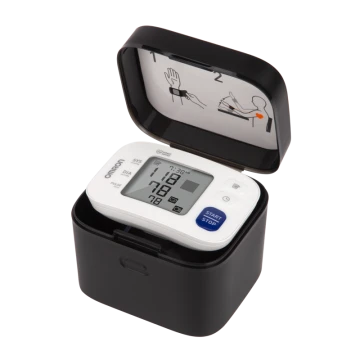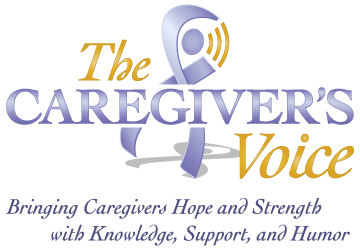If you’re growing up (older) like me or have a health condition that requires frequent blood pressure monitoring, Omron’s Wrist Blood Pressure Monitor (Model BP6100 reviewed here) is a low-cost convenient option in between visits to the doctor.

Years ago, my calm and fiercely independent father was growing stressed. During a home visit, a well-intentioned nurse, checking my father’s blood pressure, recommended safer living options. Choices included in-home care or assisted living. These meant he would lose his independence and possibly leave his home of 45 years. His systolic, the top number, rocketed above 200. He looked helplessly at me. “Please stop,” I told her. “He’s going to have a stroke!” She agreed. I asked her to step outside for a few minutes until my father calmed down. When she returned to check his blood pressure again, it had come down significantly.
Life-Saving
Life can get very stressful at times for caregivers and care recipients. We can save a life—even our own—if we know how much pressure is being exerted on our arteries as our heart beats (systolic) and when our heart rests between beats (diastolic). Knowing our numbers can alert us to a potential adverse health event. People are often unaware of an impending heart attack or stroke. Feeling dizzy or faint? Sit down and rest. Take your blood pressure. Are your numbers too low? Call for help.
Staying within Your Healthy Range
The Omron Wrist Blood Pressure Monitor* is a convenient tool to insure we’re staying within a healthy range for our age and health. Our systolic blood pressure will rise by almost 20 points while the diastolic (bottom) number will decline by about 15 as we grow older. [Caution: Check with your doctor. Each body is unique and generalities may not fit your health profile.]
As a caregiver, stress often exceeds one’s daily allowance. A caregiver for a person with dementia has added challenges of a confused person who may lash out. Your blood pressure will rise as will your care recipient’s. It’s important to monitor regularly and call your doctor if the readings continue to be out of the typical range.
You can report your blood pressure history to your doctor as this unit saves 60 readings. Access them by touching the notepad icon at the top of the display window.
Irregular Heartbeats?
This unit will also display irregular heartbeats. If your heartbeat is normal, you will see a heart icon beating in the lower-left of the monitor. If not, after two irregular heartbeat readings you’ll see a double heartbeat symbol.

Battery and Unit Life
Battery Life
Fresh batteries will provide about 300 readings according to Omron.
For those of us who get something new and need to use it multiple times a day, we might need to replace the batteries sooner. 😉 Otherwise, 300 readings will last a long time with typical use.
I reached out to Omron with one question: Can we use longer lasting lithium batteries instead of replacing with the recommended alkaline AAA batteries? Answer (paraphrased): We say alkaline because we have not tested the unit with lithium batteries and cannot guarantee the accuracy of the readings. Fair enough. Alkaline it is, then.
Unit Life
The instructions with the unit note it has a service life of five years.
Two Usage Tips for More Accurate Readings
Place the cuff at least a half-inch below the base of your palm and below your wrist bone. Despite reading the directions, I hastily put it on too close to the base of my palm. OUCH, that hurt! Don’t do that. Of course, now you may be tempted to try it. (Just like the kid who touches the stove after Mom or Dad says, “Don’t touch the stove.” OUCH!)
Raise your wrist by folding at the elbow so that the monitor is at the same level as your heart. This will give you the most accurate reading. Be sure to remain still while seated with your feet flat on the floor. No talking or chewing.
Bonus Tip:
Test on both wrists. If you test first on the right wrist and then the left; next time, test starting with your left wrist. In this way you get a more accurate representation.
Accuracy
Wrist monitors are not be as accurate as the arm pressure cuffs traditionally used in medical offices and hospitals. According to the insert that came with the Wrist Blood Pressure Monitor, this model BP6100, pressure reading is accurate within +/- 3 and heart rate, within +/- 5%. Close enough, unless your health is on the edge. I used to have a professional blood pressure monitor that wrapped around the upper arm and needed pumping to apply pressure. Over time, the hose dried and cracked rendering it useless. These days, when I see my primary care doctor for my annual check-up and for any other reason, his nurse uses a wrist cuff monitor.
One Downside
The level of the readings before the HIGH notice comes up. The standard guideline for the systolic is 120 or less and 80 or less for the diastolic. The unit will display HIGH for any number above 130 or 80. Both numbers are at the lower end of hypertension. Again, for us with 60 or more years, the systolic (top number) may read higher. If I get more HIGH readings, I will call the manufacturer to see if I can set the reading ranges for an older person. Seeing that HIGH reading makes me feel like a failure!
Hacking My Results
After a few initial HIGH readings, I took my blood pressure in bed when I woke in the middle of the night. (Ahhh. Growing up for some of us means bouts of insomnia.) What a delight when the results were of a healthy youngin’! 114/72 58BPM LOL! Okay, laugh, then ignore my hack. The idea is to use the monitor per the tested instructions. Sit up. Be calm. After a dozen tries and reading and reviewing the instruction insert, I am finally using the unit the way it was intended. And my numbers are in the normal range more often.
Bottom Line: EASY to USE. CONVENIENT. Affordable.
* This Omron Blood Pressure monitor was provided by Jennifer Moran of GraceAging.com, “dedicated to enhancing independence and quality of life for older adults and individuals with disabilities.” The specific model is
Read The Caregiver’s Voice other Reviews here.














